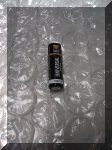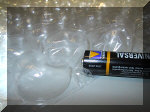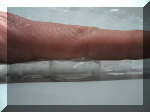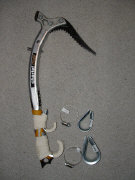|
Step1: Upper Attchment |
|
|
Step2: Modify the 'Flap' This step is not really necessary for the first tries. It only smoothens the feed. If you are uncertain if you want to use a solo-tool often, try it without this modification first. But don't worry: Sawing it off does not impact the regular use for belaying, actually it improves the handling: You can hold the grigri down and simply pull the rope upwards. The Flap is the part you can see in the red circle on the photo. |

|
|
After using my solo-grigri for some time, I found a warning on Nathanials
page added the in 1999 where he recommends
not to use the device any more. The problem with sawing off the
flap is, that this theoretically allows the rope to slip under the handle in a
fall and then the rope would be stopped by the relatively sharp edge of
the handle, possibly cutting it. To avoid this, I found a proposal on another good page, that just files the flap instead of cutting it off. I recommend to do this! The edges of the groove have been carefully smoothed down. The groove in which the rope runs does not extend below the actuating arm on the left so as to minimise the chance of the rope getting caught behind this arm which has quite a sharp edge. As can be seen on the second picture the modification allows the rope to run though the GriGri in a much straighter line. |
  |
|
Step 3: Basic Rigging |
|
|
Step 4: Start Climbing Now take your rope (regular 10-11mm, no statics of course) and fix it to your belay station with a locking biner. Make sure that it can be weighted in all directions, but especially the upwards direction is important. The rope enters the GriGri from the bottom and leaves it at the top, and then simply hangs down with the loose end. Make sure you have a (figure 8) backup knot at the end of the rope, and ideally also a couple of them in between. |
|
|
Step 5: Clipping Pro This step is a big possibility for making mistakes: When you come to clipping pro, make sure you clip the right end of the rope. The right end is the one coming out of the bottom of the GriGri ! This might look a little strange, while your waist is below the pro, but everything looks just fine when moving over it. -> Try this out a couple of times, until it becomes a habit. |
|
|
Step 6: Reach the Belay, Rapell, Reclimb When you reach the next belay station, take out the GriGri (!) attach the loose end of the rope securely, and rappel down to the start again with your favorite method. Using your GriGri for that is just one alternative, but nice, because you can stop easily while cleaning the pro. After removing your lower belay gear, you have to climb the second time, using an ascender (like the Petzl "Basic") or again your GriGri (manual feed necessary for Toproping!) |
















